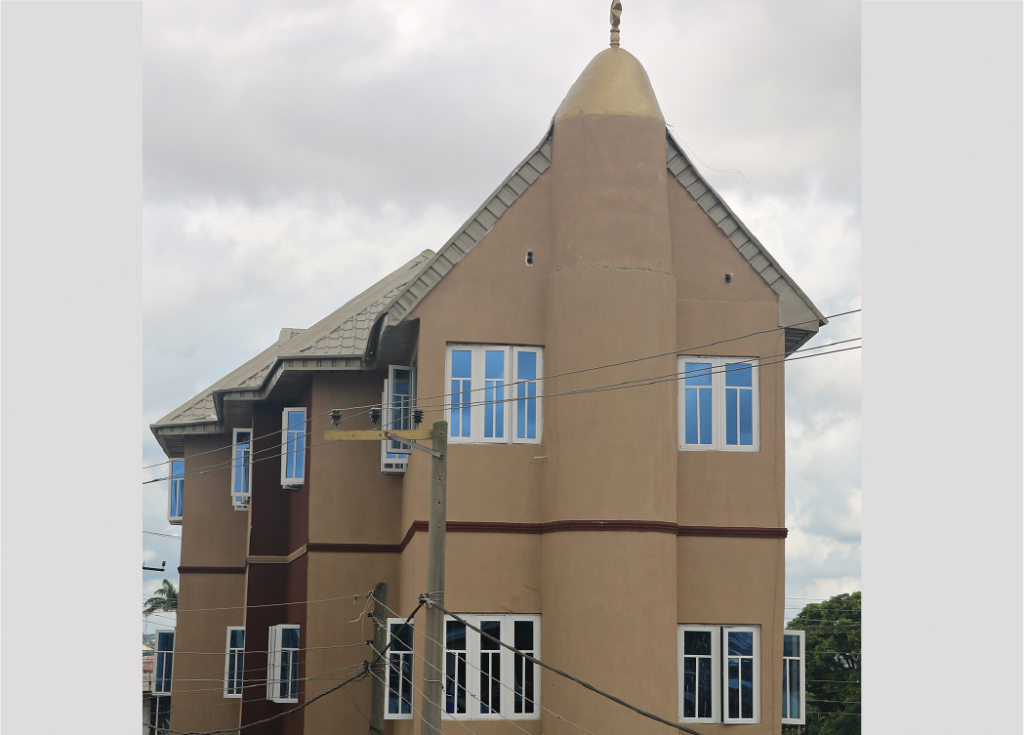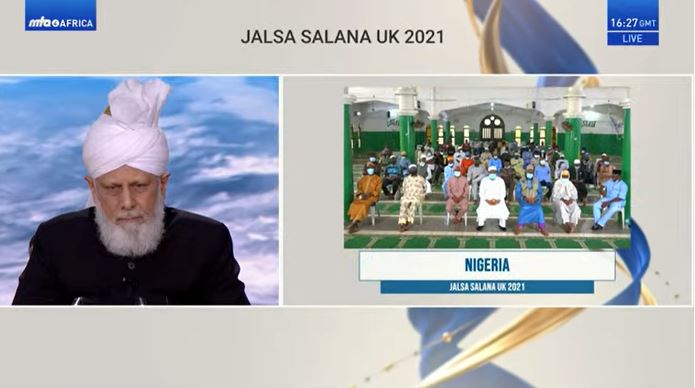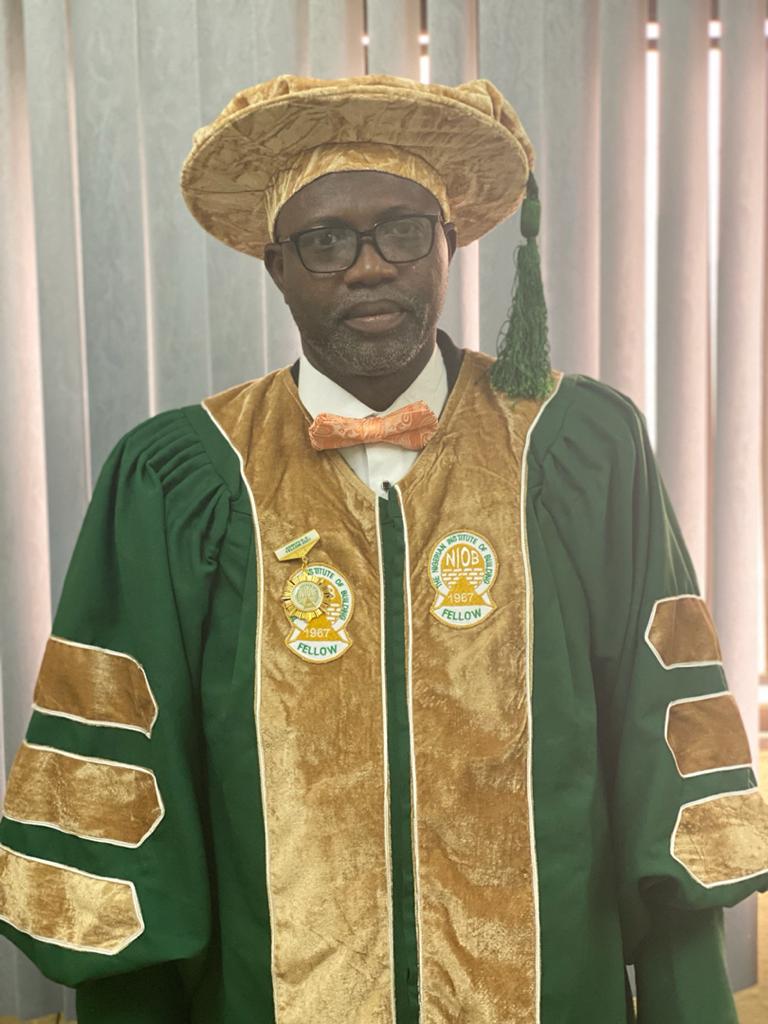AHMADIYYA OPENS ULTRA-MODERN MOSQUE IN APATA

– Lays foundation of two others in Ogun State It was a historic week for the Nigeria Branch of Ahmadiyya Muslim Community Worldwide as its National Head (Amir), Barr. Alatoye Folorunso Azeez commissioned a newly built ultra-modern Mosque in Apata (Oyo State) and a newly renovated one in Ilaro (Ogun State) respectively. The Apata Mosque was single-handedly sponsored by a family. It is a two-storey building with the ground floor set aside for ablution area and car park. It will be recalled that the foundation laying stone of the ultra-modern mosque was done in 21st March 2021, barely six months ago. At a go, the Mosque could accommodate about 500 worshippers. The same donor also completed the building of a mission house at Jankata (Apata) branch of Ahmadiyya Muslim Jama’at of Nigeria. It is a well-structured three-bedroom (ensuite) apartment meant for a would-be missionary for the branch. Similarly, the National Head also commissioned a newly renovated Ahmadiyya Muslim Jama’at Central Mosque at Igbogidi, Ilaro, Ogun State. The foundation stone of the Mosque was laid in 2001 after the plot of land was donated by Late Pa Ajayi in the year 2000. Prominent members of the Ahmadiyya Community in Ilaro contributed immensely to the successful construction of the place of worship. Barr. Alatoye, after praying fervently for the donors emphasized the importance of building mosques and mission houses, stressing that spiritual blessings and everlasting rewards from Almighty God are attached to the noble initiative. He said: “It’s more rewarding if we strive to build houses for Allah than constructing so much flats for worldly financial gains. Let us follow the footsteps of companions of the Holy Prophet who constructed buildings for the sake of Allah. We should also ensure that our Mosques are well structured and attractive than even our personal houses. “The roles of the youths in recent times towards the building of the Mosques and Mission Houses can not be over-emphasized. They are proving to be the backbone of the Ahmadiyya Community. May Allah continue to shower blessings on them.” FOUNDATION STONE LAYING OF TWO MOSQUES AT OGUN STATE In the same vein, the foundation stones of two ultra-modern Mosques were laid at Iyesi-Ijaba and Iju-Onibukun (Ogun State) branches of Ahmadiyya Muslim Community. The Amir enjoined members of the Islamic body to put their trust in Almighty God alone and strive to complete the projects in no time, not minding the economic challenges facing the nation. “It is a known fact that the nation is presently facing serious economic challenges, but we should not be bothered. We are only experiencing trying times. Almighty Allah will always pave way for his people. Let us have the mindset of completing these projects soon,” Barr. Alatoye advised. AMIR INSPECTS ONGOING MISSION HOUSE PROJECT AT SABO, ILARO On the way back to the National Secretariat in Lagos State, the National President and his entourage inspected the ongoing mission house project at Sabo-Ilaro. The project is a storey-building. The Amir led a special prayer at the site. WORKING VISITS TO EDE, EJIGBO The National Head further made short trips to Ede and Ejigbo branches of the Ahmadiyya Muslim Jama’at of Nigeria to inspect landed properties, ongoing projects and familiarise with members of the community. In his address, Barrister Alatoye urged all and sundry to always display the good qualities of Ahmadi members and serve as role models to non-members in a bid to win more souls into the religious body. “Let me use this medium to request our teeming members to exhibit true teachings of Islam. We must work on our morals and characters such that outsiders will be willing to join the Ahmadiyya train. Let us convert people with the best of behaviors and good neighborliness,” the Amir posited. WORKING VISITS TO EJIGBO
Ahmadiyya Muslim Jamaat of Nigeria Statement on Nigeria @ 61

The entire members of the Ahmadiyya Muslim Jama’at of Nigeria thank Almighty Allah for the survival of Nigeria as a country and its people to date. We rejoice with Nigerians home and abroad on the celebration of the 61st independence anniversary. The Jama’at salutes the fighting spirits of Nigerians in the face of daunting challenges in the socio-economic, political and technological spheres. Let me make it abundantly clear that Islam as a religion has no room for terrorism, banditry, kidnapping, ritual killing of human being, extortion of any kind or any act of wickedness against another fellow human being especially the aged, women and children. It is rather regrettable that despite the abundance human and material resources at our disposal, the country is wallowing in abject poverty, unemployment and under development due to lack of value system. Accordingly, the Ahmadiyya Muslim Jama’at of Nigeria urge Nigerians and government to renew our faith in the unity of purpose, peaceful coexistence and progress of the country. Pointedly, we are calling for political solutions to all agitations from contending groups. We believe if there is justice devoid of pretence and deceits, we are stronger as a country than smaller units. We advise our President, General Muhammadu Buhari GCFR, as a father for all to call all leaders of the agitators, some opinion leaders and leading traditional rulers to a crucial meeting to fashion the best peaceful and meaningful way forward. This needs to be done as urgently as possible. The Jama’at is equally worried over political developments in the country towards the build up to the 2023 general elections especially assassinations and attempted assassinations. We call on political parties to resolve their differences through an internal resolution mechanism. Politics should be taken as service to the people and not as a business of seizing power to make money through do-or-die means. Specifically, we advise that the electoral law under review should be looked at from transparent, reliable and beneficial ways. We join the call for the electronic transmission of election results in the interest of fair play and the best utilization of technology. The Jama’at noticed the spirited efforts of the government to tackle insecurity across the land. We believe the perpetrators of evil and crimes against humanity must be named, shamed, and face the wrath of the law. We pray fervently for a new order and more prosperous years ahead for Nigeria. Signed Alatoye Folorunso Azeez Amir Ahmadiyya Muslim Jamaat of Nigeria
AHMADIYYA CONTINUES TO RECORD GIANT STRIDES FOR ISLAM AS WORLD KHALIFA OF THE COMMUNITY GIVES 2021 ANNUAL GLOBAL REPORT OF ACHIEVEMENTS

The Khalifatul Masih V and Supreme World Head of the Ahmadiyya Muslim Community, Hazrat Mirza Masroor Ahmad (aba) has delivered a faith-inspiring address in which his holiness reported the annual progress and achievements of the Community on August 7th, the second day of the ongoing Jalsa Salana (Annual Convention) UK 2021. At around 5pm, Hazrat Mirza Masroor Ahmad, Khalifatul Masih V (aa) arrived at the main Jalsa Gah (Convention ground) mounted the podium and conveyed his salaam to everyone. He then delivered his historic address where he highlighted the milestones of the global achievements recorded by the Ahmadiyya Muslim Community. Addressing the thousands of members of the Community at the convention, his holiness said, ‘in this session, I usually recount some of the blessings of Allah the Exalted upon the Ahmadiyya Muslim Community, that we see and experience throughout the year. Despite only summaries being prepared of these blessings, I will only be able to present a portion of some of the facts and figures. Establishment of new Chapters [Jamaats]: By the grace of Allah the Exalted, this year, apart from Pakistan, 403 new chapters of the Ahmadiyya Muslim Community were established. In addition to these new Jamaats, the seed of Ahmadiyyat was planted in 829 locations for the first time, which means that a few or a couple of Ahmadis have entered the Jamaat in those locations. Nigeria is on top of the list of those countries where new Jamaats have been established. There, 89 new Jamaats have been established over the past years. Then, there are other countries of Africa and Europe. With relation to incidents of the establishment of new Jamaats, the missionary-in-charge of São Tomé reports that only three Islands of the country of São Tomé are inhabited. Jamaats have been established in the Islands of São Tomé and Príncipe and mosques have also been constructed there. By the Grace of Allah, this year, the Jamaat was also established on the third Island by the grace of Allah. Our missionaries went there. They preached and as a result of their preaching, ten Christians converted to Islam Ahmadiyyat. It is a small island with a population of less than a hundred. The missionary in Tanzania writes that some of our missionaries went to one of the villages of the country and they preached and propagated the faith. The people in the locality listened to the message of the Community very attentively and 60 people entered the Ahmadiyya Muslim Community. Upon this, the local imam phoned them and said that your people are coming here and creating disorder and people from amongst my community are entering the Ahmadiyya Muslim Community. The imam started arguing with the local Ahmadi missionary and he said, what are you doing, trying to convert people from my locality? Because of course, the Muslim clerics are always concerned about losing their people as they earn their bread through those people. So, our Ahmadi missionary started preaching to that imam. As a result of the debate with the local imam, the people gathered there and started listening to the debate and thirty further people entered into the Ahmadiyya Muslim Community. That Sunni imam is sitting in his mosque idle because only a handful of people come to his mosque, whereas hundred or close to hundred people have formed a new chapter of the Ahmadiyya Muslim Community on that area and the nizam of the Community is established. In Guinea Conakry, the clerics of the Islamic League had threatened the local people of a village with regard to Ahmadis, saying that Ahmadis were disbelievers, God forbid. They said that Ahmadis did not have any relation with Islam and so people should not listen to them. However, when the message of the Promised Messiah (as) was preached to them and they were told of the prophecies related to the Latter-Day Messiah and Imam Mahdi, the entire village along with the local imam accepted Ahmadiyyat. The system of the Jamaat has now been established there. However the clerics of the Islamic organisation kept threatening the local villagers, they said that they had found new pleasure in their prayers, which they were unaware of before accepting Ahmadiyyat and that they would remain steadfast on this path. Establishment of new Mosques: In terms of the establishment of new mosques, which includes mosques that the Jamaat constructed as well as those that came into the possession of the Ahmadiyya Muslim Community during the year, their number is 211. Ghana is on top of the list with most mosques being constructed there. Then, there are also other countries. In Belize, the first Ahmadiyya mosque has been constructed, which spans over an area of two acres and has a capacity of 220 worshippers. Its foundation was laid in December 2019. It is a very beautiful mosque. It has a mission house, the missionary’s office, a library as well as a guest room. There are two highways that go out from Belize City, one going towards Mexico and the other one towards Guatemala. This Noor Mosque is located on the highway that goes towards Guatemala. It is located at a distance of two miles from the city’s centre. After the mosque in Guatemala, this is the second purpose-built mosque of the Ahmadiyya Muslim Community in Central America. For the construction of this mosque, three brothers from Canada went there to volunteer. They also participated considerably in the construction of another mosque in Canada. These are Mansoor Sahib, Manzoor Sahib, Fareed Sahib and Mudassir Sahib. In any case, they went to Belize and worked towards the construction of the mosque. At first, the construction was estimated to cost 2.5 million US dollars. In the end, it only cost 125,000 US dollars as a result of these voluteers’ efforts. The local people also offered significant sacrifices for this project. In Zion, in the United States of America, there was a plan to construct a monument. The Ahmadiyya Muslim Community in Zion wanted to make a
Ahmadiyya New Clinic in Kano Underway

The Ahmadiyya Muslim Jamaat of Nigeria has commenced the building of another Clinic in Kano for more improved health care services to the people of the State. The foundation laying ceremony was performed by His Royal Highness, Alhaji Aminu Ado Bayero, the Emir of Kano, the Amir Ahmadiyya Muslim Jamaat Nigeria, and the representative of Kano state Governor, the Commissioner of Health at the Ahmadiyya Muslim Jama’at complex along Zaria Road opposite the Kano Economic City. Once the new Clinic is completed, kano state will have three medical facilities and two schools for the overall benefit of the populace. Historically, the Foundation stone of the first Ahmadiyya Clinic in Kano was laid by late Royal Highness Alhaji Ado Bayero on 28 Dec 1968. It has now been upgraded to Ahmadiyya Hospital Kano. Before that, on 14 October 1967, Alhaji Aminu Kano; who was then the Federal Commissioner for Telecommunication visited Ahmadiyya Dispensary Apapa under the management of Retried Lt. Col Dr. M Y Shah described the activities of the Dispensary as “Wonderful work for humanity and peace.” On 19 February 1974, His Excellency, Alhaji Audu Bako, the Executive Governor of Kano State laid the foundation of Ahmadiyya College in Kano when Maulana Ajmal Shaid was the Amir of Nigeria. He was present at the occasion. This Secondary School has attracted many local and international awards to Kano through academic and sports laurels. Ahmadiyya Understanding of Islam The Amir, Head of Ahmadiyya Muslim Jamaat of Nigeria, Barrister Alatoye Folorunso Azeez used the occasion to reiterate the essence of understanding Islam from the perspective of the Ahmadiyya Muslim Community to the effect of service to humanity in all ramifications. He stated that the Ahmadiyya Muslim Community believed that Almighty Allah sends the Holy Prophet Muhammad as a mercy unto mankind. Therefore, in addition to upholding the five pillars of Islam and six articles of faith, a Muslim preoccupation is to be a mercy unto mankind by making life easier for them, to serve Allah in an atmosphere of peace. Accordingly, the Jamaat has a Non-Governmental Organization called Humanity First whose preoccupation include: 1. Global Health for all by building Hospitals and Clinics 2. Knowledge for All by building Schools 3. Orphanage Care 4. Water for life 5. Gift of Sight 6. Food security 7. Refugee Resettlement 8. Community Care; and 9. Disaster Relief. He noted that Humanity First through the present Medical Director of Ahmadiyya Hospital Kano has treated thousands of people on the “Gift of Sight “ scheme free of charge. Similarly, through the Principal of Ahmadiyya College Kano, Humanity First had sunk many boreholes in the suburb of Kano metropolis to provide drinkable water to those environments. Barrister Alatoye equally said that the Founder of Ahmadiyya Community laid emphasis on Islam as a religion of peace, hence the current Khalifa, spiritual head of the Ahmadiyya Muslim Community globally is preoccupied with how the world will achieve global peace and has made several tours before the Covid 19. Nigeria was one of the countries on the list before the outbreak, hence the visit was halted. His key message during the tours is how the world will embrace justice and peace and he has written many books on this. The Amir appreciated the cordial relationship among the Palace, the Kano State at large, and the Ahmadiyya Muslim Jamaat for the realization of sustainable developments through the provisions of a Hospital, equipped with ultra-modern facilities, unique primary and secondary schools, and now a new clinic in Kano alone. Both the Emir of Kano and the Kano state government equally appreciated the gestures of the Ahmadiyya Muslim Jamaat of Nigeria.
2021 EID-UL-ADHA MESSAGE: OBEDIENCE TO THE WILL OF ALLAH – THE PEAK OF SACRIFICE

Ashhadu anlaa ilaha illallah wahdahu laasharikalahu wa ashhadu anna Muhammadan Abduhu warasuluhu. Ama’bad fauzubilliahi minashaitaani rajeem, bismillahi Rahmani Raheem. What is Eid-ul-Adha Eid-ul-Adha is a “feast of sacrifice” or submission to the wishes or will of Allah celebrated on the 10th day of Dhul Hijja or the 12 Lunar month. It means total submission to what Allah wants or wishes or will or directs. It has two components. The smaller component is the sacrifice or killing of ram. This smaller one reminds us annually or points to a bigger sacrifice. The bigger sacrifice is the sacrifice of one wishes, will, passion, ego, and pride for the wish of Allah which is very difficult. To surrender one’s disobedient tendencies, passion for greed, or selfishness for the instructions of Allah is very difficult except for the righteous or God-fearing. Elements of Sacrifices All praise belongs to Almighty Allah who has made us witness the 2021 Eid-ul-Adha or feast of sacrifice amidst various global and national challenges. This requires a high level of spirit of obedience to Allah. Without the spirit of respect, the spirit of obedience would not work. Without the spirit of humility, neither spirit of respect nor obedience will work. And without the spirit of righteousness or godliness, one cannot be humble. These are essential components of sacrifice. You cannot offer acceptable sacrifice without being righteous. Allah will not accept it. It is not all sacrifices that Allah accepts. In Suratul Maidah 5. 28 – Almighty Allah says that: ‘………….Allah accepts only from the righteous.” اِنَّمَا یَتَقَبَّلُ اللّٰہُ مِنَ الۡمُتَّقِیۡنَ…. Origin of Eid-ul-Adha Sacrifice Eid-ul-Adha or the festival of Sacrifice commemorates the obedience of Hazrat Ibrahim (as) and his son Hazrat Ismail(as) to the commandment of Allah. Hazrat Ibrahim(as) had a series of dreams in which he saw himself sacrificing his eldest son Ismail. He inferred that it was perhaps the will of God that he should sacrifice the life of his son. Hazrat Ibrahim(as), being most obedient to God, was about to sacrifice the life of his son Ismail, when God commanded him to stop and gave him the good news that he had indeed fulfilled His command. God was so pleased with Ibrahim because of his obedience that He multiplied his progeny into billions. He was also given the great honour of being the forefather of the Holy Prophet of Islam(sa). Those who are able to offer the sacrifice should remember the significance of doing so, as succinctly stated in chapter 22:38 of the Holy Qur’an: Their flesh reaches not Allah, nor does their blood, but it is your righteousness that reaches Him. Thus has He subjected them to you, that you may glorify Allah for His guiding you. And give glad tidings to those who do good.” The act of sacrifice is symbolically reminding the person who offers it that as the animal is inferior to him so he, also, is inferior to God and should, therefore, be ready to sacrifice himself and all his personal interests and inclinations for the sake of God when he is required to do so. The same applies to a Muslim who desired to offer the sacrifice but could not, for economic reasons. The attainment of righteousness should be the goal of every Muslim. The Holy Quran further states: Verily the most honourable among you in the sight of Allah is the one who is most righteous among you. (49:40) Eid-ul-Adha is an occasion on which Muslims everywhere are encouraged to renew their commitment to making every kind of sacrifice for the spiritual, moral, social, and economic uplift of mankind and especially their own. If they make it a common cause and strive to manifest in themselves the attributes of God in accordance with the teachings and guidance of the Holy Quran and teachings of the Holy Prophet then, indeed, the message of Eid-ul-Adha would have borne fruit. Referring to attaining Taqwa and excelling in spirituality, the founder of the Ahmadiyya Muslim Community, the Promised Messiah(as) said that we should love Allah as if we have died in His way. Just as we slaughter animals, we should consider ourselves slaughtered in the way of Allah. When anyone’s Taqwa is less than this, then it is not a sufficient level of Taqwa. The significance of Eid-ul-Adha is obedience to the will of Allah and killing or suppression of one passion or greed. The current World-wide Head of the Ahmadiyya Muslim Jama’at in His Message of Eid-ul Adha said that “It is a reminder that one should sacrifice oneself for a greater good. This greater good that a Muslim should always be ready to sacrifice oneself for is the Almighty God, by way of sacrificing their time, wealth, honour, and life.” He further said “Understanding the true spirit of sacrifice is even more important in this day and age where some nations are usurping the rights of others; where the blood of human beings is being wasted for minor worldly goals. On the Eid Day – Remembrance and Gratitude – Eid Ground and Covid-19 Remembrance of Allah and gratitude to Him is the hallmark of that day. There is the exaltation of Allah to and from the Eid praying ground. One significant aspect of Eid-ul-Adha is the slaughtering of animals. On the day of Eid those Muslims who can afford to sacrifice an animal are enjoined to do so after Eid Prayer. However, this aspect should not be taken as a do-or-die affair. The offering of animal as a sacrifice is only incumbent upon those who can afford to do so. With the prevailing increase in prices of all consumables including animals, many Muslims may not be able to buy rams for the Eid. The Almighty Allah knows our individual capacity and does not burden us beyond it. No Muslim should resort to un-Islamic means to offer this sacrifice. We are grateful to Allah who out of His infinite mercy has given us the privilege to witness this year’s Eid-ul-Adha. We are
BLDR TOWOLAWI EMERGES A FELLOW OF THE NIGERIAN INSTITUTE OF BUILDING

Al-Hamdu Lillahi Rabbil-‘Alamin Congratulations to Bldr. ASIMIYU-TOWOLAWI BASHIR-UD-DIN S. (FNIOB), on your induction into the College of FELLOW OF THE NIGERIAN INSTITUTE OF BUILDING on Tuesday 13th July 2021 @ International Conference Center Abuja. The Nigerian Institute of Building (NIOB) is the professional body for Builders and those who are about to be engaged in the Building Profession. The Institute has challenged new fellows to live up to the high expectations of society. NIOB president, Mr. Kunle Awobodu, and the Chairman of its College of Fellows, Mrs. Adebolanle Araba gave the charge at the first-ever virtual induction of members into the fellowship cadre of the institute.
AHMADIYYA GRADUATES NINE MISSIONARIES

The Ahmadiyya Muslim Community, Nigeria Branch has graduated nine (9) Missionaries at its School of Theology (Jamiatul-Mubashireen) located at Ilaro, Ogun State. The graduands who had successfully completed their four-year programmes comprised of five (5) Nigerians, three (3) Beninoise, and one Cameroonian. Their names are Adeyemi Habeebullah (Nigeria), Apooyin Abdulroqeeb (Nigeria), Gongola Abbas (Nigeria), Badrudeen Abdul Azeez (Nigeria); Ajakaye Mujtaba (Nigeria); Hafiz Ayeroumi Abdul Kabir (Benin Republic); Hafiz Ibrahim Shafii’ (Benin Republic); Isa Alabi Mustapha (Benin Republic) and Nuhu Yusuf Baba (Cameroon). Alhaji Alatoye Folorunso Azeez, the National Head of Ahmadiyya Muslim Jama’at of Nigeria who was the Chairman of Convocation Ceremony enjoined the newly graduated Missionaries to live up to expectation by displaying attributes and characters of a true reformer. Barrister Alatoye also urged the new Missionaries to always upgrade themselves morally and educationally by making researches and professing solutions to world crises. He added that it can only be possible through fervent prayers. “Today, I congratulate you all on your well-deserved convocation ceremony after four years of rigorous training at Jamiatul-Mubashireen. You have all chose to be reformers, therefore you should always display good attributes of reformers. Your work is a blessed and professional one. It has both worldly and divine rewards. You are on the track to teach the people to be Godly.” “Missionaries are researchers. You are expected to research on lasting solutions to the challenges facing the world. You must then support your solutions with prayers.” “You must preach with the goodness of your behaviors. Also train and retrain yourselves to be better. Always follow the right path and guard against evils from money and women. Above all, go to the field to reform the people with good characters and prayers,” the Amir stated. The National Head also sounded a note of warning to Jamia students generally in respect to the rules and regulations of the institution. His word: “The aim of the institution is to produce reformers of good repute and proud ambassadors of Ahmadiyya Community. Any candidate coming to Jamia must be steadfast, God-fearing and upright. We can’t afford to produce unfit missionaries to the society.” “When you are opportuned to be in Jamiatul-Mubashireen, do not attempt to violate the rules and regulations, the punishment is very stiff. Please follow all the rules guiding the institution.” The Acting Missionary Incharge, Maulvi Abid Abdul Waasi enjoined graduands to always request His Holiness for prayers and seek for his guidance on all their daily routines. Certificates of Excellence were later given to the graduating students. Academic and sporting event prizes were also presented to outstanding students. Prominent among the guests include the National leader Majlis Ansarullah Ahmadiyya Nigeria (Elders’ Forum of Ahmadiyya Community), Alhaji Abdul Waheed Adeoye and National leader Majlis Khuddamul Ahmadiyya Nigeria (Youth Wing), Dr. Sanni Taofeeq.
ALHAJI OWOLABI ELECTED AS CHAIRMAN NCRIB

Alhaji Abbas Owolabi has emerged the Chairman Nigeria Council of Registered Insurance Brokers (NCRIB) Abuja Chapter. Based on his contributions to the body over the years, his experience cum dexterity in the profession, Alhaji Owolabi was unanimously elected as the head of the body, succeeding Mr. Lateef Omoladun whose tenure expired earlier in the year. NCRIB was founded in 1962 and incorporated in 1967 as a non-profit making organization backed by Act 2003. Its aims and objectives is to maintain central organization for all insurance brokers in Nigeria, watch over legislation, afford means of arbitration on, or for settling disputes, collaborate with government and various institutions and professional bodies, organise conference, seminars and workshops for insurance brokers as well as formulate standard of practice and conduct of members. The new chairman whose company – Hansworth M.A. Insurance Brokers Ltd., registered with NCRIB since 2001 had earlier served as the Vice Chairman for two consecutive terms. Alhaji Owolabi promised to lift the body to greater heights and therefore solicit support from all and sundry to actualise the dream. “My plan as the Chairman is to improve on the relationship with the insuring public by organising road walk to sensitize the public, radio and television shows. I also plan to improve on the I.T. skills of our members as well as improving the general welfare of our members by effecting certain policies on insurance,” Alhaji Owolabi noted. Alhaji Owolabi is an active, dedicated, and responsible member of Ahmadiyya Muslim Jama’at of Nigeria, Abuja Branch. He was formerly the Abuja President of the Branch.
REFLECTING ON MY JAMIA GRADUATION DAY AND THE MISSIONARY CAREER

By Al-Hafiz Yunus Omotayo It’s always exciting reminiscing the day of my graduation from Jamia Ahmadiyya (Theological Institute established by the worldwide Ahmadiyya Muslim Community for the training of Missionaries) at Ilaro, Ogun State, Nigeria, which took place 15 years ago, precisely on 16th July, 2006. Indeed, it forever remains an historic, significant, inspiring and catalytic event in my life. Historic, because the graduation symbolized my departure from a student life to my formal induction, along with my colleagues, into the Missionary profession as life-devotees in the service of the religion of Islam. Significant, because it hallmarked the beginning of a professional career which champions the mission of divine prophethood, sparking the challenge to imitate the exemplary prophetic moral and spiritual life to be able to win the hearts of humanity. Inspiring and catalytic, because it transported me to the plateau of self-realization and consciousness that to strive for distinction and excellence in one’s study, in one’s work and in one’s career is not only rewarding in the final analysis, but also what actually defines the true meaning of meaning when it comes to actualising life’s goals and destiny. My reflection goes back to 2003 AD, the year that my academic adventure began in the Jamia. Over twenty students, drawn from the six geopolitical zones of Nigeria, have been admitted to undergo the rigorous missionary training. However, three years later, on the day of the graduation, only six of us have got the fortune and the grace of Allah to make it to the end of the course. We were: Adam Garba, Adeleke Ismaīl, Ajibola Abdullah, Aliyy Ishaq, Yunus Omotayo and Yunus Fayomi. The rest have had to drop out, for one reason or the other. Although I was born an Ahmadi Muslim, but I didn’t have the opportunity to learn about Islam during my childhood, because I found myself in a Christian-dominated society where my socialization at the peer and age group levels, as well as, both my primary and secondary educational adventure saw me learning Christian Religious Knowledge (this has, however, turned out to be a blessing in disguise, anyway). My study of Islam only began from the level of self-study towards the end of my secondary school and continued in my post-secondary years well to the year of my admission to the Jamia Ahmadiyya. Hence, in the spirit of the Qur’ānic imperative: “And the bounty of thy Lord, proclaim;” I’m ever humbled with deep sense of gratitude to Allāh to reminisce and relate the grace of Allāh Who enabled me to emerge successfully from the Jamia. Thus, the 2006 Jamia Convocation saw my worthless self receiving the prize for the best graduating student. This unassuming boy also bagged a certificate of Tahfizul Qur’an (Memorization of the Qur’ān), and a prize for being the first student to become a Hafizul Qur’ān (honorific title for a memorizer of the Qur’ān) in the history of Jamia Ahmadiyya Nigeria. And according to the then Missionary In-Charge of Nigeria, Maulana Abdul-Khalique Nayyar Sahib, it was second to the trail-blazing feat achieved by respected Ahmadiyya’s Mufti Silsila, Maulana Kahloon Sahib, in the world history of Jamia Ahmadiyya International. More so, the event also cheered my humble self with a number of prizes from the sport fiesta of the year: 1st position in 100 meters race; 1st position in 200 meters race; and 1st position in table tennis (single), among other prizes. I could still recollect that I represented the final-year level in the Extemporary Speech Competition organized for the year. I was the Ra’ees (the Students’ President) of the 2006 set. The pressure to win the competition was indeed challenging to me: how would one relate the story that a student representing a lower level defeated the Ra’ees who was representing the final year level? The day arrived and the event commenced. My turn came and I was called forward to pick my topic. I did. To my surprise, however, I read the question that asked me to speak on “My Favourite Teacher.” I was shocked. All my lecturers were seated. The thought of who should I choose among them dominated my mind. They, too, were staring at me; perhaps, thinking who will Yunus speak on as his favourite teacher. For a few seconds, I remained mute, confused and indecisive. I felt if I should choose one, how would the others feel about it and me? I knew I have had to take a decision not just inevitably, but also wisely as well; so as to, at best, please them all, or, at worst, play safely. Then the thought flashed my mind: why not speak on the Holy Prophet Muhammad (saw) as my favourite teacher! Now, I felt I’ve gotten the best option in the best prophet who is the ultimate favourite teacher of the people of all time and clime. It worked excellently. I made it and added another 1st position prize for Extemporary Speech Competition! Jamia Ahmadiyya, through its broad curriculum and esteemed and erudite lecturers, taught us Islam: its theology, jurisprudence, law, history and the Scholastic Dialectics. It took us on an academic voyage to extensive comparative religious studies. It engaged us in philosophical and psychological studies. We were taught world languages: Arabic, English and Urdu! We were trained in Islamic morality and spirituality and in the principles of dedication to the service of the faith. We were taught that a Missionary must be a dictionary, and should learn something about everything. We were taught to see ourselves as both leaders and servants of the faith and of the faithful. More so, we were made to undergo rigorous physical training and dignity of labour. We were instructed to serve as builders of personalities, to see ourselves as social workers and, above all, as callers to the oneness of Allāh and the prophethood of Muhammad (saw) – the Seal of the Prophets. However, at the end of the course, just when we were about to begin to breath a sigh
REMINISCING MY QADIAN JALSA EXPERIENCE

Maulvi Nurudeen Okubena By the special grace and mercy of the Almighty Allah, I was privileged to attend the 2018 Jalsa Salana Qadian, India. It was actually my first presence and experience in Qadian, the birthplace of Hazrat Mirza Ghulam Ahmad (as), the Promised Messiah and founder of the worldwide Ahmadiyya Muslim Community. As an African Missionary leaving the shores of Africa for the first time, I was filled with happiness and a great aspiration to see Qadian. On arriving at Qadian after a journey of several hours on road from New Delhi, and despite witnessing such cold weather for the first time in my life, the sight of Qadian was indeed pleasing and I was more pleased when I saw more than thirty (30) fellow Africans at the Conference with a very high spirit and great enthusiasm to participate in all the Jalsa proceedings. I was exceptionally marvelled with the spirit of brotherhood at the Jalsa and, most especially, with the high spirit of sacrifice displayed by the workers at the Convention. Both the young and old were always ready to offer every sacrifice for the comfort of the guests of the Promised Messiah (as). The volunteers on security duties were always there at every moment, even in the extreme cold of the night. May Allah reward them all abundantly. One great thing about Qadian was that everyone meets each other with cheerfulness and happiness. Most especially when some of our Indian/Pakistani brothers realised that an African Missionary, like myself, could speak and understand the language of the Promised Messiah (as); they all showed great love and affection. Another wonderful scenario I witnessed at Qadian was that, despite the extreme cold weather, you would find people very early in the dawn trooping in large numbers to participate in the Tahajjud (the supererogatory night Prayer). I could remember that while there, I tried on so many occasions to observe prayers at the Mubarak Mosque but, on every occasion, I was told the place is filled up. However, I eventually had the opportunity to do so. Alhamdulillāh! It was indeed pleasing to have the opportunity to pray at Baitu Dua, Baitul fikr and several other rooms of the Promised Messiah (as). One surprising fact is the enthusiasm and zeal in every attendee to get an opportunity to pray in these holy rooms, and one could see a feeling of contentment and conviction of acceptance of prayers in the countenance of everyone who had had the opportunity of praying there. While in Qadian, considering the distance we traversed to reach there, one thing that always struck my mind was how the message of the Promised Messiah (as) was able to spread from such a remote village to the entire world. This, therefore, further strengthened my conviction that he, indeed, was a Chosen One of the Almighty Allah. Another striking thing about Qadian is the feeling of tranquillity one experiences while there. One always feels secured in Qadian. And, even, adherents of other faiths who live nearby do how high level of love and affection to all Jalsa attendees. Also, witnessing the presence of the attendees at Jalsa who have traveled from different parts of the world, I could see the fulfilment of the prophecy vouchsafed to the Promised Messiah that: يأتيك من كل فج عميق That is, “He shall come to you from every far region.” I was able to meet people from virtually all the continents of the world and everyone displayed a great level of love for the other. I was extremely pleased with the various speeches at the event. The facilitators were versatile and learned and the speeches were really soul inspiring. Qadian is a place to be visited by all, to experience the bounty and favours bestowed by Allah to the Imam of the Age. May the Almighty Allah give us all the grace to do so. Aameen Maulvi Nurudeen Okubena Head of Programming, MTA Africa, Nigeria Studios
